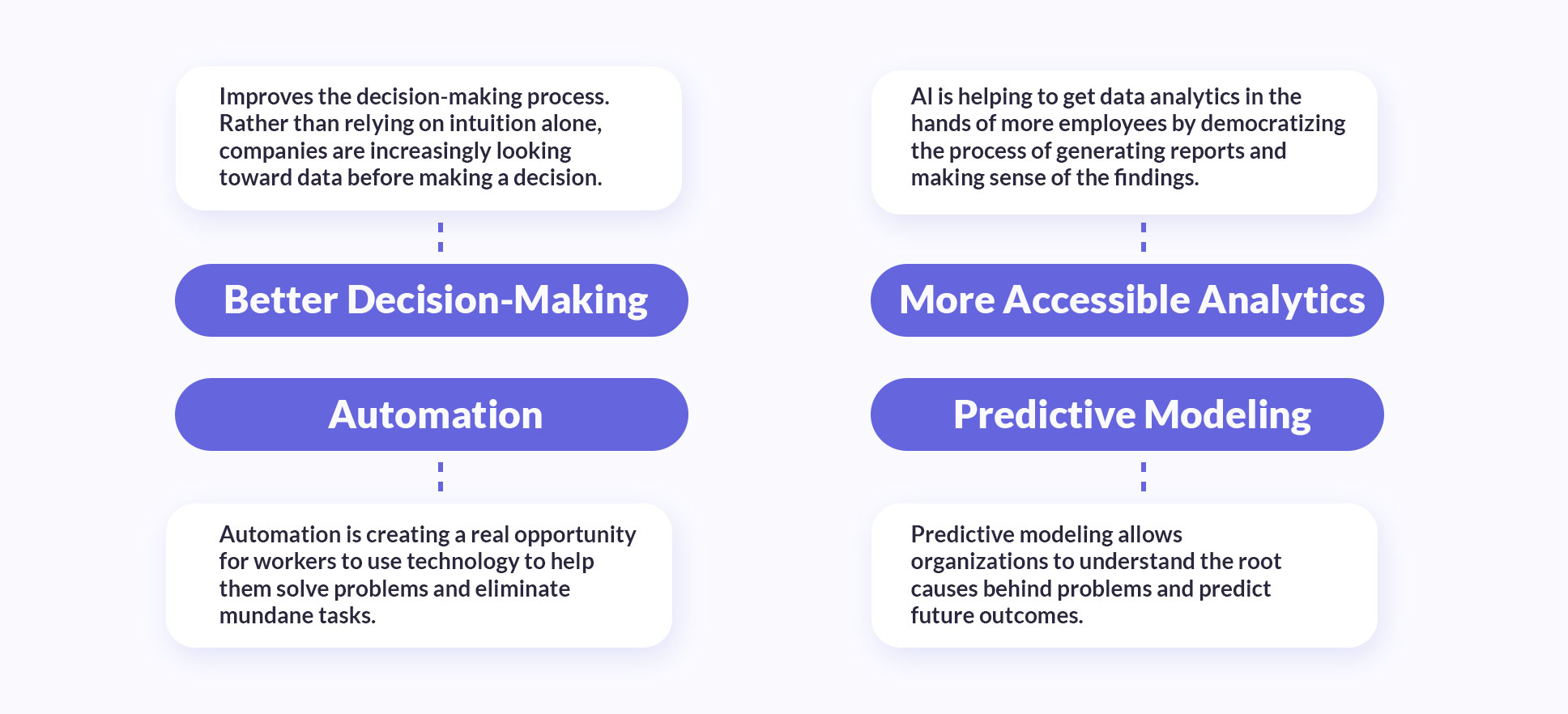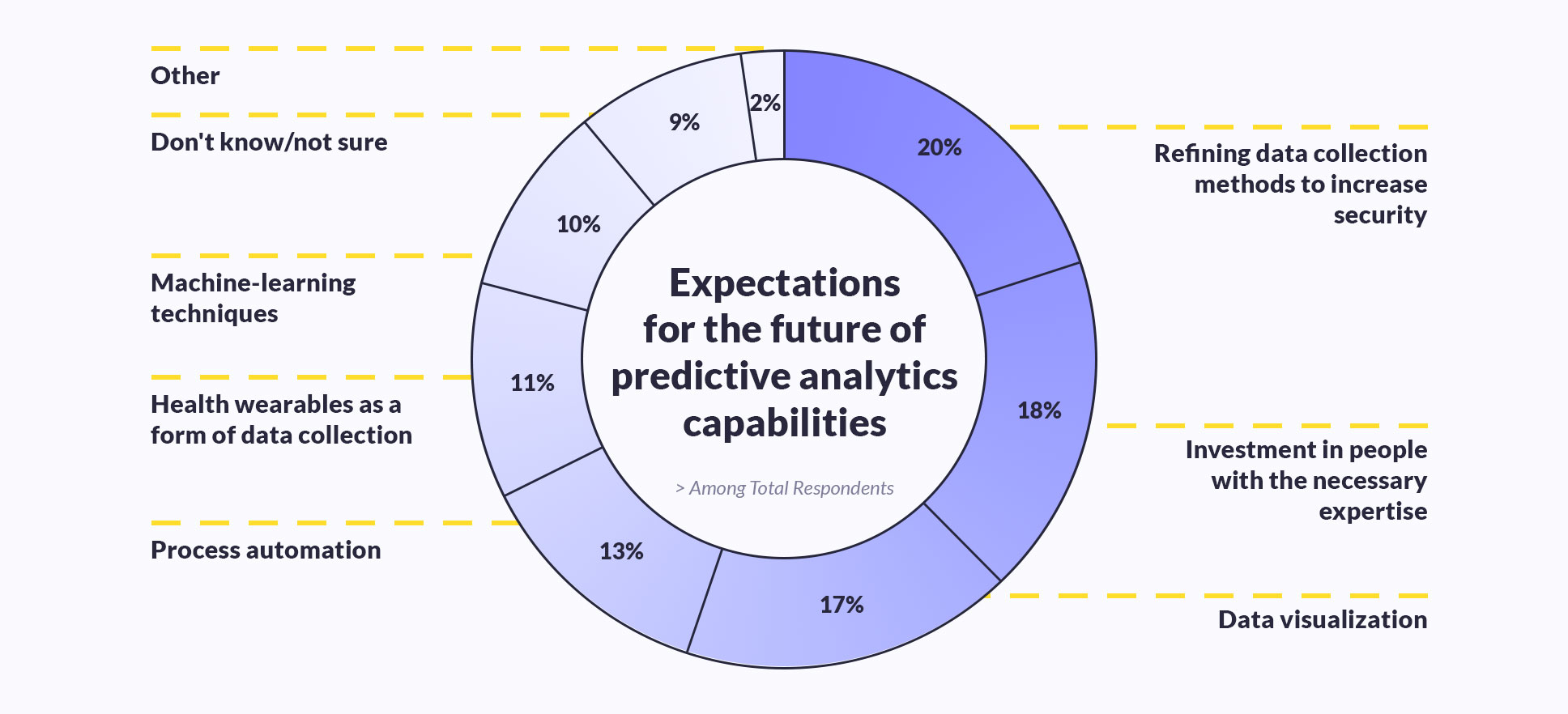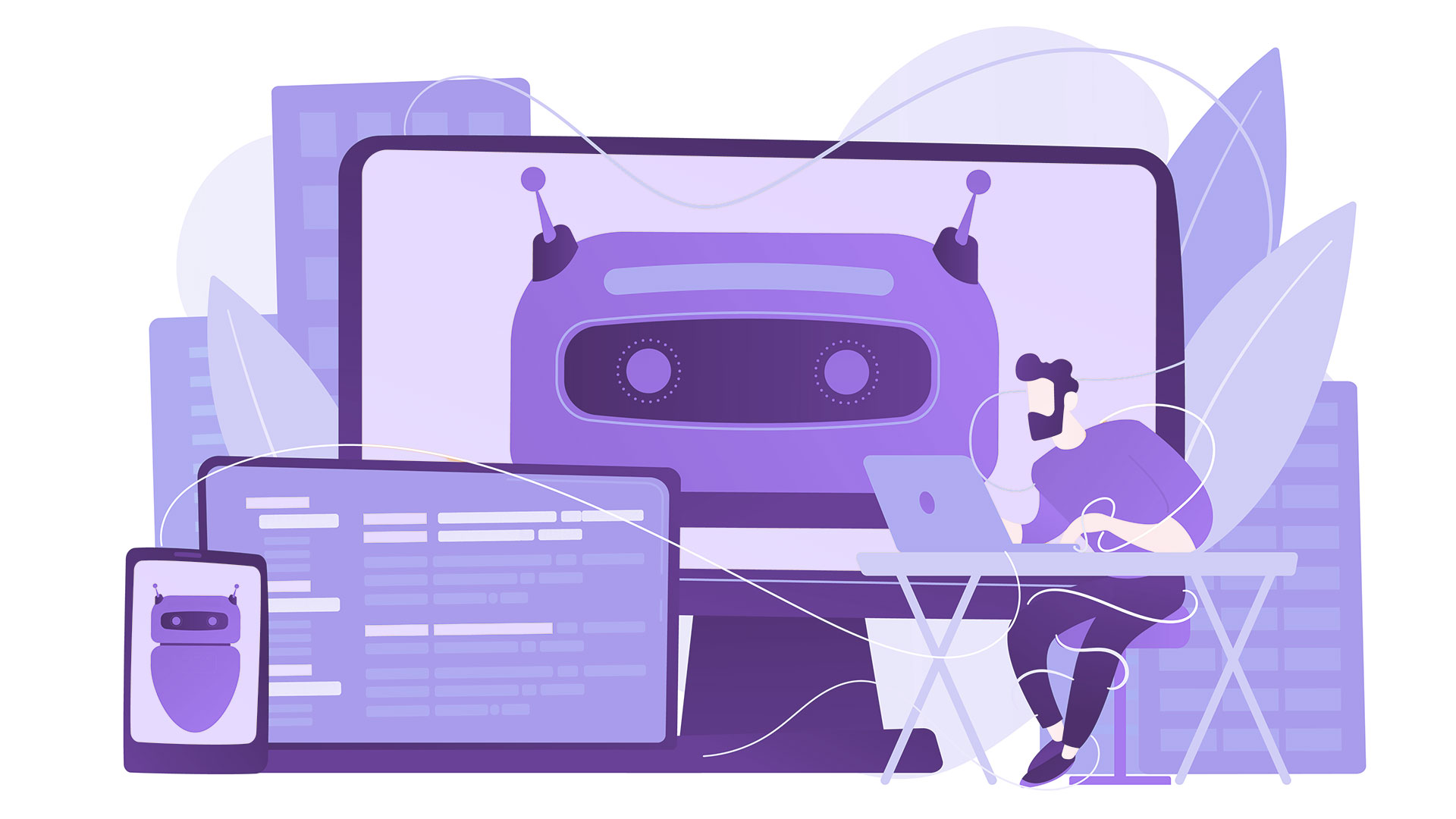The impact of predictive analytics on our daily lives is huge, with sectors such as healthcare, banking, retail, and more using data to enhance their operations. Predictive analytics uses historical data with statistics to make future decisions. Artificial Intelligence (AI) is bringing new changes and making predictive analytics models more accurate and actionable.
Data scientists believe we are entering a period where AI will oversee and manage most tasks, emphasizing its lasting presence. AI can process vast amounts of data at unprecedented speeds to help businesses optimize their workflow. By leveraging AI-powered app development services, companies can integrate predictive analytics into their applications, offering real-time insights and enhanced functionality.
A report from Grand View Research further emphasizes this sentiment: “The global artificial intelligence market size is projected to grow at a CAGR of 36.6% from 2024 to 2030.”
Let’s dive deep and examine predictive analytics and artificial intelligence and how they work together to help businesses make reliable and beneficial decisions.
What is AI-powered predictive analytics?
Predictive analytics is a data-centric process that offers reliable future outcomes based on historical data and ongoing trends. It focuses on data science and how different departments within an organization can collaborate to drive profitability.
After the data mining process, the gathered data is structured and analyzed based on specific criteria and goals. However, with the advancements made in AI, large and mid-sized businesses can now use predictive analytics for processing and analyzing data more than before.
This helps understand customer preferences, pinpoint potential hazards, and devise contingency plans to minimize losses. Businesses can become more proactive instead of being reactive in making decisions.
Difference between AI and predictive analytics
AI uses computers and machine learning models to analyze data and make decisions based on factors and insights. However, predictive analytics identifies trends and makes assumptions based on human intervention.
The most obvious difference is that AI is autonomous and learns continuously. In contrast, predictive analytics is often used by humans to derive decisions and solutions by analyzing current and historical datasets manually.
Don't miss out on the chance to set new standards in a tech world!
Partner with us and discover endless opportunities with AI-powered applications.
How predictive analytics and AI work
AI-powered analytics harnesses machine learning based on neural networks to create valuable insights. Unlike conventional analytics, AI-based analytics primarily need human intervention during the initial phase when ML algorithms are provided with training data. Here are some applications of AI analytics.

- Demand forecasting. Leveraging its predictive capabilities, AI can anticipate product demand. By analyzing stock availability, historical purchase patterns, and seasonal trends, it can project future product needs, improving inventory management and procurement strategies.
- Data consolidation. Artificial intelligence analytics can quickly gather and analyze data from diverse platforms and systems, presenting a consolidated view. This is particularly beneficial for businesses with fragmented systems or those aiming to analyze customer information across multiple data sources.
- Business outcome projections. With the ability to process vast datasets, AI analytics can predict potential outcomes. This enhances business decision-making by providing insights into the repercussions of possible strategies.
- Audience demographic analysis. AI analytics can shed light on your audience's demographics, including their buying behaviors, locations, ages, and genders. A more detailed understanding of your audience helps you personalize content and refine customer targeting.

You may be interested
Top 5 Generative AI Use Cases For Your FinTech Business
Find out about FinTech operations with AI: enhanced experiences, fraud detection, personalized advice and more.
Read the articleThis equips the algorithms to recognize patterns and analyze data, generating actionable insights and forecasts from business data. Below are some applications of predictive analytics across industries.
Fintech
With predictive analytics models and historical data analysis, financial businesses can drive data-driven decisions, minimizing risks, while enhancing customer experiences. At Genuisee, we utilize our fintech AI development services for businesses to provide them with the following benefits:
By analyzing historical patterns, detect potential fraud and suspicious transactions in real time and prevent them.
Get predictions on default risks for loans and investments, which facilitates smarter financial planning.
Provide your customers with personalized recommendations by analyzing their behaviors.
Help investors in selecting assets and balancing portfolios to maximize returns while mitigating risks.
Improve asset allocation by predicting market trends and fluctuations.
Streamline processes like underwriting, loan approvals, and resource allocation by automating data-driven insights.
Use case: At Genuisee, we implemented an advanced AI-driven predictive analytics solution for a financial services platform, enabling users to manage and optimize their investments more effectively. The application utilizes machine learning models to analyze historical financial data and provide accurate predictions on portfolio performance, risk management, and market trends.
We managed to deliver the following:
Real-time forecasting insights into future market conditions
Tailored financial advice based on individual risk tolerance and investment goals
Streamlined decision-making by identifying patterns and anomalies in financial data
Retail
Retail businesses can benefit from predictive analytics in identifying customer patterns which helps tailor shopping experiences. Another significant area of impact belongs to inventory optimization. Let’s take a closer look at the benefits AI models bring to retailers:
Demand forecasting. Optimize inventory levels, reducing overstock and stockouts.
Personalized marketing. Analyze customer habits and offer tailored product recommendations.
Dynamic pricing. Adjust pricing strategies in real time based on market demand.
Customer retention. Identify at-risk customers and implement loyalty programs to enhance engagement.
Fraud detection. Monitor transactions to identify suspicious activities and prevent retail fraud.
Use case: Geniusee collaborated with Wyzoo to develop a model prediction service that assists businesses in selecting target audiences more effectively. The application analyzes customer data enriched by an extensive database of consumer attributes, enabling businesses to:
Identify high-performing audience segments. We enabled our client to determine which customer groups are most likely to respond positively to specific marketing messages.
Improve response rates. The platform allows tailored marketing strategies to increase engagement and conversion rates.
Integrate multiple data sources. Our team developed a comprehensive view of customers and prospects by consolidating various data streams.
Attract customers efficiently. By optimizing marketing spend, the client now focuses on segments with the highest potential ROI.
Manufacturing
By integrating IoT and AI-powered predictive analytics, manufacturers can anticipate equipment maintenance needs. This proactive approach:
prevents machinery breakdowns
ensures smooth production
predicts the potential issues before failures
decreases equipment downtime
Reduces maintenance time and cost
enhance workplace safety
Use case: Our client Electron, operating in the manufacturing sector, sought a cost-effective way to modernize their production line by accurately tracking the performance of their old press systems without requiring a complete overhaul.
Our AI experts developed a compact, AI-driven monitoring system designed to track and count production strikes with exceptional accuracy. The solution uses advanced analytics to monitor vibrations and generate actionable insights, enabling the client to improve production efficiency and reduce downtime.
Here’s what we managed to achieve:
Enhanced operational visibility. The system provides precise, real-time monitoring of press activity, ensuring consistent production tracking and improving operational oversight.
Cost-effective modernization. By upgrading existing press systems with AI technology, the client avoided the need for expensive replacements, significantly reducing modernization costs.
Data-driven maintenance planning. Predictive analytics identified wear-and-tear trends, enabling proactive maintenance scheduling and minimizing unplanned downtimes.
Improved production efficiency. High accuracy in strike counting allowed the client to optimize production processes, reducing errors and ensuring consistent output quality.
Scalable solution. The lightweight and scalable system provided a foundation for future enhancements, offering flexibility to adapt to the client’s evolving needs.
Effective AI integration ensures that predictive analytics tools work harmoniously within current infrastructures, maximizing their potential.


Thank you for Subscription!
Benefits of AI-based predictive analytics
Let's summarize the benefits predictive analytics provide businesses with:
Enhanced decision-making. AI-driven analytics helps businesses make informed decisions by providing deeper insights from vast datasets.
Cost efficiency. AI analytics optimizes processes, leading to greater cost savings and lower resource requirements.
Personalized customer interactions. AI algorithms can tailor customer experiences based on individual preferences and behaviors, improving overall customer satisfaction.
Seamless integration. AI analytics tools can be easily integrated into existing systems, ensuring a smooth transition. A few examples of AI analytics tools are SAS Advanced Analytics, Alteryx, MicroStrategy Analytics, and TIMi Suite.
Boosted productivity. By automating data analysis and image recognition, AI allows employees to concentrate on strategic tasks, enhancing overall productivity. Real-time insights also enable quick action, driving positive business outcomes.
Advanced pattern detection. AI excels at identifying patterns within massive datasets. By leveraging the power of deep learning, businesses can detect fraud and analyze emerging trends, even when data is scattered across various platforms.
Adaptive learning. The flexibility of machine learning algorithms ensures that AI analytics tools are continuously learning. They adapt to new data, ensuring that insights remain relevant and accurate.

The future of AI-powered predictive analytics
AI neural networks adapt and refine their outcomes with self-learning algorithms. It excels in pattern recognition, helping you make automated decisions, freeing up time, improving inventory management, and enhancing customer service efficiency.
As AI accesses more data, its response will become more refined. Businesses harness AI-driven predictive analytics to retain and attract customers. The future of AI predictive analytics can evolve and extend to:
- Forecasting market demands and trends
- Anticipating potential risks and fraud detection
- Analyzing past and current customer behavior
- Recommending task allocations
- Crafting personalized customer experiences

Image Source: Health IT Analytics
While predictive analytics existed before AI, it was largely based on educated guesses and past sales data. Now, with AI and machine learning, predictive maintenance is more precise and comprehensive. AI systems can follow patterns overlooked by humans and offer unbiased predictions.
As businesses amass more data, their AI predictive models will improve. For example, an AI-equipped supermarket can predict a customer's needs based on their purchase history and other factors.
The emergence of AI tools like ChatGPT and platforms like TensorFlow, Scikit Learn, and Theano signals a future where predictive analytics is automated.

Some useful info
Comparison Of Generative AI Tools For Development And Prompt Engineering
Choose wisely: A brief overview comparing Generative AI tools.
ExploreConclusion
As datasets expand, the integration of AI in predictive analytics is also expected to increase. Merging big data with AI-driven analytics offers many advantages, improving the data analysis process and the overall business performance.
Companies using AI or aiming to adopt AI-powered predictive analytics should take essential steps in updating their systems, adjusting their risk strategies, and minimizing potential user mistakes. While this is easier said than done, our artificial intelligence solutions can help your business stand out with the best data analytics and decision-making algorithms.
So, carefully weigh your options and adopt the best AI-based predictive analytics for your existing operational structure and business.





















